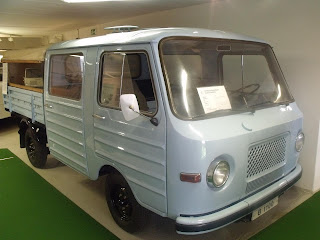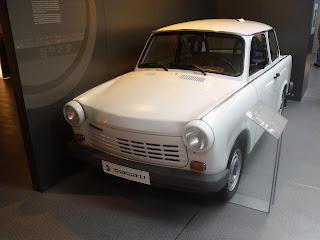the small town of Frankenburg, which is about 15km from Chemnitz.
Without my Garmin Sat-Nav we would have had difficulty finding the place
as it's not signposted and is not in the centre of the pretty little German town.
The Museum here is a small, very low key affair, but in some ways it was the nicest
of the 3 museums we visited.
 |
| Outside front of Museum |
I had noticed that most days and on the day we were visiting, they only opened
from 1pm-4pm. I knew I was returning to Berlin that day, when planning our trip and had
emailed this museum in advance asking them if there was any chance we could
visit around 10.30-11.00 am.
 |
| LT 200 |
Surprisingly, and with typical German efficiency, the lady who works there daily,
emailed me back and said that that was no problem.
Not only that, but when we got there she had arranged an ex-factory employee to be
onhand to show us around the museum and presumably to answer any questions I had.
I say presumably because the poor man didn't speak any English and I only have a handful
of German, so our meeting initially was somewhat farcical as I realised he expected
me to speak German. I had used an internet translation site to send them an email in German,
so I knew he expected me to be more conversant than I was able to be.
 |
| LT300 |
The Woman receptionist there has a few words of English and regardless of what language
anyone speaks or doesn't speak, it was obvious that these two people were delighted that
someone from Ireland wanted to visit their museum and learn about the history etc.
The man left us to wander around for a while and when I was taking pictures he helpfully
opened the bonnets of the cars so I could take shots of the engine bays and also invited me
to sit into any of the vehicles I wanted to.
Small kindnesses and gestures mean a lot especially when it's difficult to communicate.
This was a nice gesture after visiting the Horch Museum and the one in Eisenach, where the
cars are all kept locked and the Horch museum all had signs up saying 'Don't touch'.
 |
| Barkas B1000 |
The Museum is small and I doubt it receives many visitors. I met a Trabant Rally driver
who lives only 15 minutes away from it and he admitted he'd never been to see the exhibit.
But although small, it has an impressive selection of vehicles and an interesting history.
The Museum opened to the Public in 1993.
The brand FRAMO is the predecessor of what would become BARKAS and started
up here in Frankenburg in 1923. Framo is short for Frankenburg Motor Works and the company
was founded by the man behind DKW, Jorgen Rassmussen and two colleagues Richard Blau,
and local man Paul Figura.
 |
| Barkas B1100 prototype with 1500 Moskvitch 4 stroke engine. 1972 |
Intially though the company was named Metall-Werke Frankenberg GmbH (Frankenburg
Metal Works)
The company was set up to manufacture Motorcycle parts for the DKW Motorcycle Plant
in Zschopau, which it did successfully until 1927.
Then, production started in the Frankenburg factory of a three wheeled motorised Tricycle, the
TV 300. This was no ordinary trike and was sturdily built as a freight vehicle for the transporting
of goods and merchandise for local businesses.
As the name suggests it was powered by a 300cc, 2 stroke engine with only one cylinder.
The engine came from DKW.
The lightweight design and reasonable price made these trikes popular with tradesmen and local
shopkeepers like Butchers and Bakers.
Further, similar designs would follow in much the same vein, with slight variations and engines
usually of either 200 or 300cc.
Production moved from Frankenburg to Hanichen in 1934 and the company would soon branch into
four wheel vehicles, including a car called the Piccolo.
It is from 1934 that the company was renamed as Framo-Werke Hainichen
The Piccolo car was not a success and sold in few numbers,
after which the Factory reverted back to making small commercials with three and four
wheels.
 |
| 1961 Framo V901/2 |
In 1938, the Company brought out a range of small vans and pick-up trucks that used a 500cc
DKW engine, with two stroke power and two cylinders.
This was known as the V500 and was a big success for Framo.
Then development stopped with the onset of War and the factory was retooled to supply weapons
for the German Army.
Around 500 Female Prisoners of War were conscripted to work in the Hanichen Factory for the War
effort. These prisoners came from the nearby Flossenburg Concentration Camp, that had a
sub-camp in Hainichen.
When the War ended in 1945, this area of course was within the Russian Sector and the factories
were dismantled, crated up and sent to Russia as War reparations.
The Hanichen factory regrouped eventually and started again to produce their V500 model from
1949, with the models designated as V501/502.
In 1951, the larger but cosmetically very similar V901 and V902 were created and displaced the
smaller 501 and 502 eventually.
The V900 models used an adapted version of the IFA F9 engine, itself a DKW pre-War design and
copy.
In 1961 a new factory was built in Karl-Marx-Stadt ( now Chemnitz) to produce a new commercial
van type vehicle, named the Barkas.
That year, the Barkas B1000 was launched and was way ahead of its contemporaries
and the competition.
It used the Wartburg 353, 2 stroke engine of only 993cc and the gear box from the
same car.
Surprisingly it went rather well and wasn't as seriously underpowered as you would think, thanks
to an ingenious exhaust system that generated huge amounts of torque that enabled it to pull
a ton of weight plus its own.
The downside to this was poor fuel economy. Nomatter how hard or easy they're driven, it seems
that 20-23 mpg is all they return. Top speed was good for approx 60mph.
Their weak spot was the clutch that wasn't strong enough for a commercial vehicle, having been
made for the Wartburg 353 car and most Barkas's would have seen a clutch or few in its time.
 |
| 3 fine Framo's with 500cc 2stroke power |
The Barkas was made in several variants, a van, pick-up, flatbed truck, a minibus
and customised versions for the Army, Police, Ambulance and Fire Department.
It was comparable in quality, usability and reliability to the VW Transporter van of the same era.
It's pretty remarkable that a one litre engine could carry a Ton of weight, which added to its own
would be close to 2.5 tonnes, yet the Barkas was well up to the job and was the only small
Commercial of its kind made in East Germany, so it saw plenty of use from Emergency
Services to Tradesmen to Delivery men. It was manufactured in two stroke form
until 1990 and until 1991 in four stroke, when it received the VW engine that the Wartburg
1.3 got in its final stages of production.
 |
| that superb Barkas chassis! |
So how did it manage to pull and carry such weight?
 |
| front view of chassis mated to 1.3 VW engine |
The answer is a combination of things, but the biggest single factor in this is the chassis
of the Barkas which needs to be seen up close to be believed and appreciated.
It's an incredibly sturdy creation made from heavy steel that incorporates a huge outrigger
on each side that takes the bulk of its payload and by so doing, takes the pressure and
stress of the engine and gear box. This, added to the huge torque supplied by the
ingenious exhaust system and you have a very capable, commercial vehicle that belies
its small engine.
The van was also front wheel drive, typical of the Dkw inspired mechanicals, but very
unusual for a commercial van type vehicle in 1961.
The suspension also used semi-trailing arms which was quite advanced for this type
of vehicle.
 |
| engine bay of Barkas B1000 between front seats. Two stroke engine |
There's a particularly fine Barkas, custom made for Hohenschonhausen Prison in East
Berlin and displayed there. It was made to look like a fish delivery van from the outside
but inside had six individual holding cells for prisoners.
The engine of the Barkas is situated between the two front seats, so the body shape
really makes the most of the space it has inside. The 9 seater minibus type has loads
of room inside and is more spacious than the VW model of the same time.
Barkas, like AWE and Sachsenring made many prototypes of both engines and vehicles
that never made it into production. The Museum has a fine Barkas B1100 prototype that
looks like a fine vehicle, especially when it was made in 1972 and was intended to replace
the B1000. This prototype used a 1500cc, Moskvitch Four stroke engine.
Sadly, this and many others from all the East German auto makers was denied by the
powers that be who would spend as little as possible on new technologies.
I really enjoyed this visit to all three museums and getting to see parts of the former
Gdr was good too. I expected general costs to be cheaper, most consumer goods
and eating out was more expensive than Berlin.
But, Berlin is a very cheap city to spend time in. More competition I guess is healthy!
 |
| Author pictured in Barkas B1000 |




































